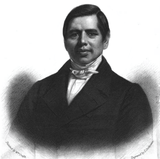Portal:Christianity/Selected biography/2009
January
During Tkach's tenure, the changes that he implemented stirred much controversy and significant dissent among those who continued to follow Armstrong's theology. The dissenters labelled the changes as heresy and many left to form new church organizations. Within the mainstream Christian community, some have hailed Tkach's reforms, which brought a church from the fringe to orthodoxy, as unprecedented in the history of the Christian church.
The first major change under Tkach's tenure was the WCG's doctrine on healing. Previously the church taught that true believers were healed by faith in God and not by doctors. Tkach asked the church leadership to study the question. Once Tkach was satisfied with the results of the study, he officially softened the church's teaching on the matter, encouraging members to seek proper treatment while retaining faith in God as healer.
(more)February
Augustine was the prior of a monastery in Rome when Pope Gregory the Great chose him in 595 to lead a mission, usually known as the Gregorian mission, to Britain to convert the pagan King Æthelberht of the Kingdom of Kent to Christianity. Kent was probably chosen because it was near the Christian kingdoms in Gaul and because Æthelberht had married a Christian princess, Bertha, daughter of Charibert I the King of Paris who was expected to exert some influence over her husband. Before reaching Kent the missionaries had considered turning back but Gregory urged them on and, in 597, Augustine landed on the Isle of Thanet and proceeded to Æthelberht's main town of Canterbury.
King Æthelberht converted to Christianity and allowed the missionaries to preach freely, giving them land to found a monastery outside the city walls. Augustine was consecrated bishop of the English and converted many of the king's subjects, including thousands during a mass baptism on
March
April
Wesley was a preacher of righteousness, exalting the holiness of God. This preaching, as Paris Reidhead accounted of Wesley, "wasn't trying to convince good man that he was in trouble with a bad God - it was trying to convince bad man that he was in trouble with a good God."
Methodism was a successful
Wesley helped to organize and form societies throughout England, Scotland, Wales, and Ireland, small groups that developed intensive, personal
Under Wesley's direction, Methodists became leaders in many social justice issues of the day, including
Throughout his life, Wesley remained within the Church of England and insisted that his movement was well within the bounds of the Anglican Church. His maverick use of church policy put him at odds with many within the Church of England, though toward the end of his life he was widely respected.
(more)May
Peter Jones (January 1, 1802 – June 29, 1856) was an
June
Portrait of Bishop Clement of Dunblane
July
Nigel (c. 1100 – 1169) (sometimes Nigel Poor or Nigel of Ely) was an Anglo-Norman
August
Ælfheah (954 – 19 April 1012;
September
Martin Bucer (or Butzer) (11 November 1491 – 28 February 1551) was a
October
Cosmo Lang as archbishop of Canterbury, c. 1932
(William) Cosmo Gordon Lang, 1st Baron Lang of Lambeth,







